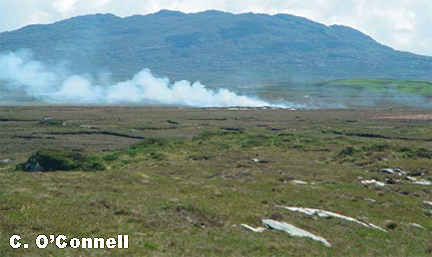 Effects of Burning on Peatlands
Effects of Burning on Peatlands
Many landowners burn the dry, dead vegetation on peatlands to encourage new lush growth to sustain their livestock. Other fires may be started maliciously, by accident or through natural causes. Fire builds up over the bog burning the tops off the Sphagnum mosses. The cushion or hummock forming mosses on the bog surface are particularly sensitive to fire including Sphagnum imbricatum and Sphagnum fuscum.
Fire catches in the heathers and shrubs, as there is more fuel to burn down. It hollows out the shrubs creating bare peat. Fires will remove the vegetation from mineral soil islands in peatlands and low hummocks in the flat bog. In the year following the fire there is good re-growth of graminoid species but not of heathers. A single fire can provide the right conditions for the invasion of scrub and trees.
Given the right conditions, fire can be extremely damaging to peatlands. Apart from either killing or driving out wildlife, in very dry conditions, fires can burn unabated for days on the open peatland. Once the protective vegetation layer is gone, the peat surface is subject to erosion and it’s related problems and it may take many years for the vegetation to recover and recolonise. Hot fires may also continue to burn within the peat after they have been extinguished on the surface, causing fires to restart on the surface several weeks later. Regular burning has long lasting impacts on peatland vegetation even if the intensity of fires is low. Regular burning prevents the build up of combustible material in litter and keeps dwarf shrubs in check. Frequent fires also produce flushes of plant nutrients which encourage sedges and grasses. Plants such as moor grass and single headed bog cotton can tolerate low and medium intensity fires since their growing bud is below ground or well protected in the heart of a tussock.
Restoration Measures
Recolonisation of a peatland after fire damage depends on the wetness of the peat surface, the peat texture, the proximity of available seeds or spores to the burnt or bare area and on the ability of mosses to colonise from their spores. These factors are influenced by the intensity of the fire.
To encourage recolonisation of a burned peatland surface with peat forming vegetation, please follow the link to Restoration of Industrial Cutaway Peatlands The methodology proposed is dependent on having a water table level within 30cm of the peatland surface. Pease follow the link to Restoration of Drained Peatlands.
Prevention of Fires on Peatlands
Erecting warning signs of a peatland area prone to fire is a first step in prevention particularly if the careless disposal of cigarette butts from passing traffic is a cause of fire.
A second step is the construction of a fire break around the peatland site. This involves cutting the heather bushes, grasses and other shrubs with a strimmer down to the moss layer. The width of the clipped strip should be a minimum of 4-5m. The cut vegetation is removed from the site. This strip gives a base from which to fight a fire should one arise and in the event of fire it will slow down the rate at which the fire travels.
Text, Photographs and Images © Irish Peatland Conservation Council, Bog of Allen Nature Centre, Lullymore, Rathangan, Co. Kildare. Email: bogs@ipcc.ie; Tel: +353-45-860133
.
